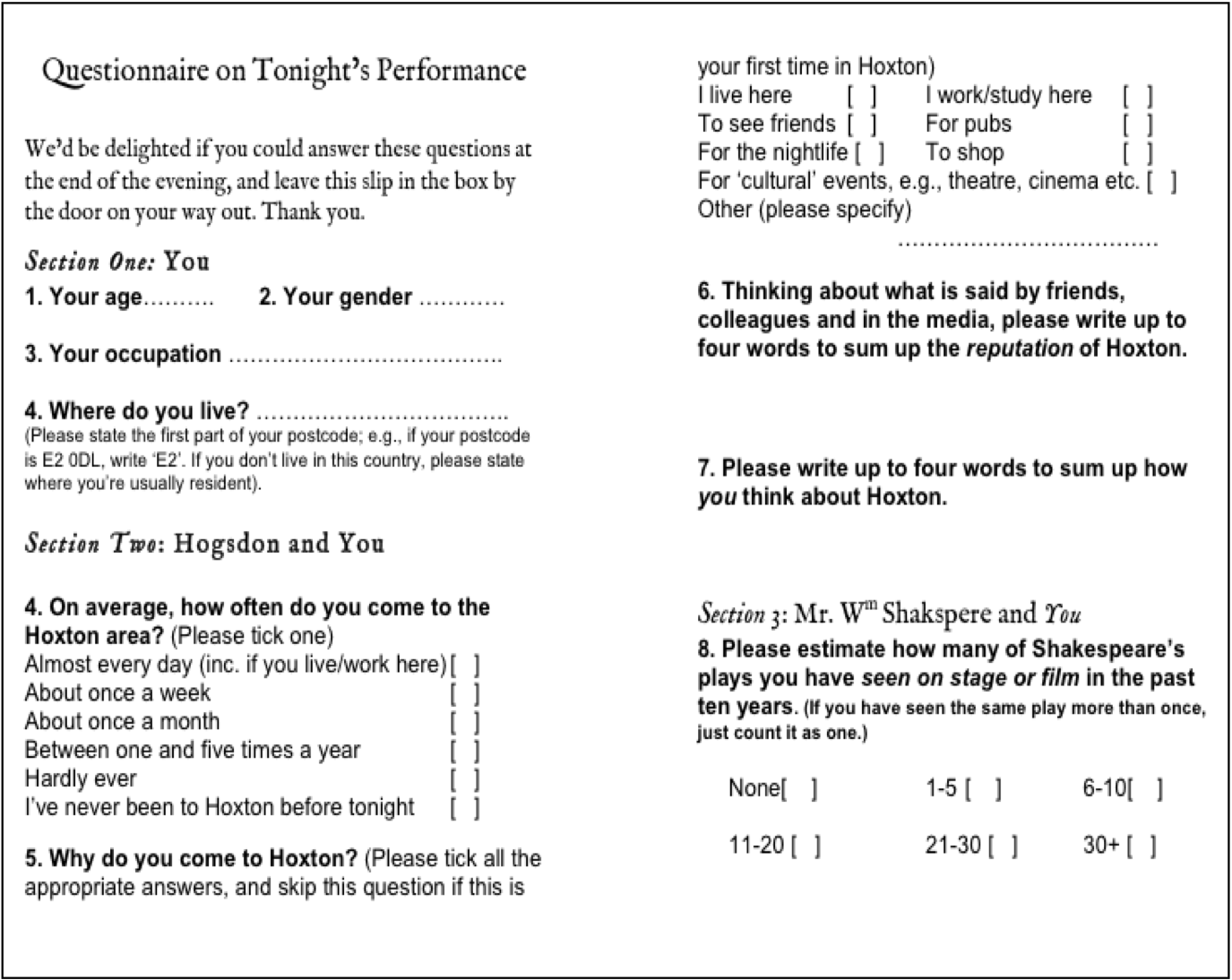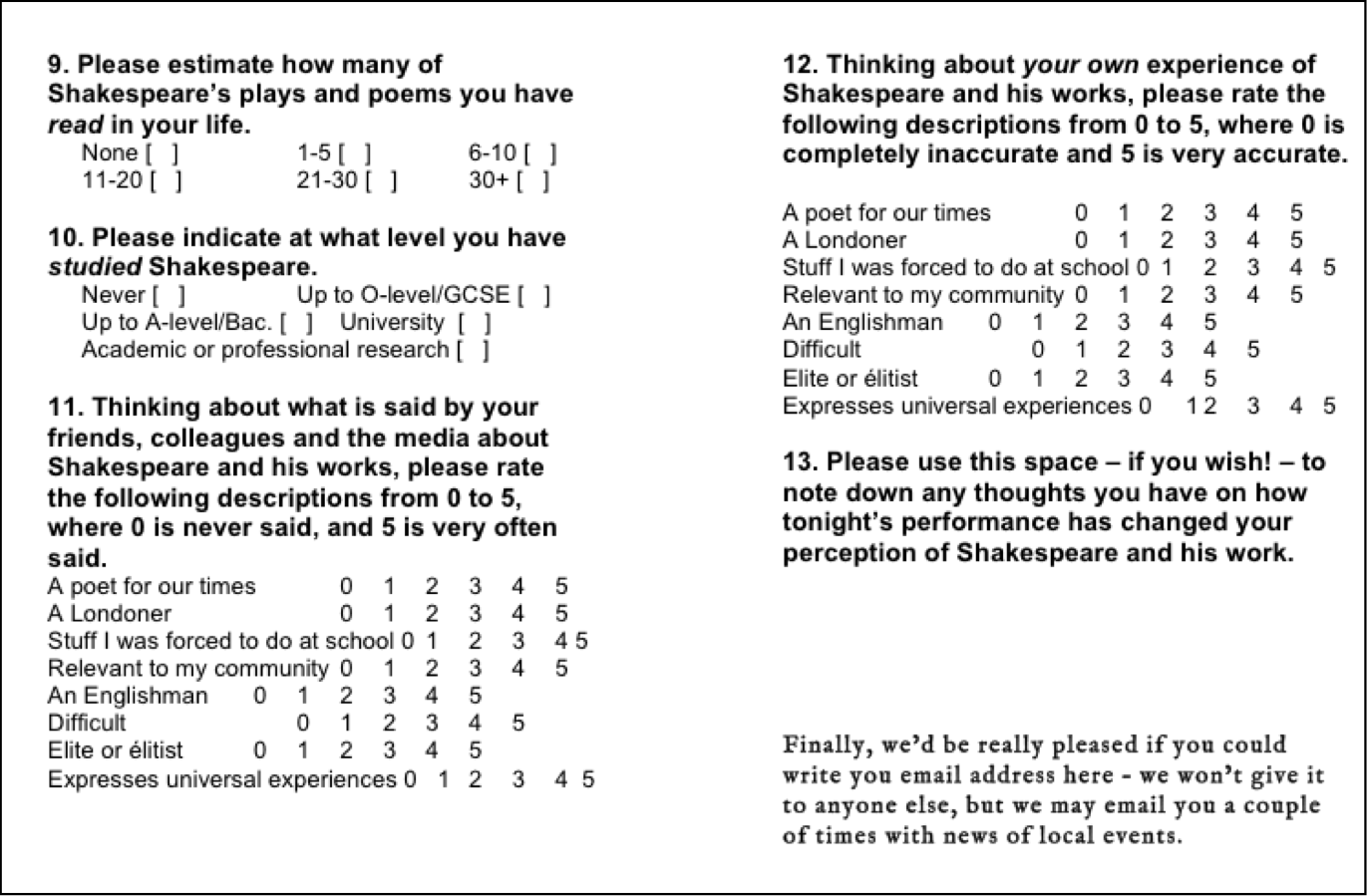'Tis a mad world at Hoxton’: Leisure, License and Local History in The Tempest
Submitting Institution
St Mary's University, TwickenhamUnit of Assessment
English Language and LiteratureSummary Impact Type
CulturalResearch Subject Area(s)
Language, Communication and Culture: Literary Studies
History and Archaeology: Historical Studies
Summary of the impact
The impact described here concerns the history of Hoxton, London, in the
late sixteenth and early seventeenth centuries, especially in relation to
Shakespeare's The Tempest and the anonymous poem Pimlyco, or
Run Red Cap — `Tis a mad world at Hogsdon. As outlined
below, the project adds to the cultural capital of this inner-city area of
London, and gives one of Shakespeare's most famous plays `back' to the
inhabitants of the city where it originated.
Underpinning research
The content of the underpinning research is contained in Peter Howell's
essay `Tis a mad world at Hoxton: Leisure, License and the Exoticism of
Suburban Space in Jacobean London' (Literary London, Autumn 2013),
and in his scholarly edition of the poem Pimlyco (www.otranto.co.uk/index.php/publication/view/52).
As part of a wider project on the history of Shoreditch and its environs,
the research was undertaken by Peter Howell, a Lecturer in English, during
the period 2010-2012. The essay demonstrates that a significant source for
Shakespeare's The Tempest is this long, anonymous poem published
in 1609, written in praise of a tavern and its ale, called `The Pimlyco'
or `Pimlico', in Hoxton, northeast of the City of London. This poem
construes this then-suburb as an island, and in so doing borrows a great
deal from those stories of the New World written about the Roanoke
expeditions in the 1580s, and the Jamestown expeditions of 1607-8. The
essay claims that Shakespeare's conception of an enchanted island that has
been colonised, and where inhabitants change their personalities
temporarily, but that is nonetheless located in the Old World, is in part
taken from this poem. There are also a number of textual and extra-textual
features that link this poem, and the tavern in Hoxton that it concerns,
to Shakespeare's play. These links solve the central problem of
postcolonial readings of The Tempest: why is a play about the New
World set very specifically in the Old? Shakespeare already had a
precedent for this in the Pimlyco poem. The claims of this research also
imply that The Tempest has a more local referent than has usually
been said; as well as thematisation of the `big' ideas of colonisation,
dispossession, creativity and forgiveness, it also depicts practices of
transformational licence to be found in the suburbs of early modern
London.
References to the research
Details of the impact
The research was disseminated in two main ways, each having its own
distinctive but complementary impact:
1. Shakespeare in Hackney; or, `Tis a mad world at Hoxton,
by Peter Howell and Matthew Hahn (Drama St Mary's), dir. Matthew Hahn,
starring Jack Klaff.
This is a redacted and dramatised version of the poem, produced in
collaboration with the Theatre Arts team of St. Mary's University College.
It was premiered on 23 May 2013 at Hoxton Hall, a theatre in Hoxton,
London, close to the location of the Pimlyco tavern in the early 1600s,
and was followed by a lecture by Peter Howell on the poem, the local
history of the area and its relevance to The Tempest. A recording
of the performance is available at www.otranto.co.uk/index.php/pages/index/pimlyco-13.
A total of 78 people bought tickets for the performance, and they were
asked to fill in a questionnaire concerning attitudes to Hoxton, and
attitudes to Shakespeare. 25 completed questionnaires were received (the
questionnaire can be found at the end of this section), a summary of which
follows:
- 24 of the 25 respondents lived at least three miles from Hoxton; 5 of
the respondents came to Hoxton `between 1 and 5 times per year' or more
often, and the rest had `hardly ever' or `never' been to Hoxton. As
such, there is evidence that the performance drew an audience into an
area with which they were not previously familiar.
- Respondents were asked to write up to four words to sum up the reputation
of Hoxton, and up to four words to sum up their own opinion of it,
having seen the show. Many predictable responses came up in both
categories — `grungy', `edgy', `up-and-coming', but some transformative
effects were evident:
| How often in Hoxton |
Reputation |
wn Opinion |
| Hardly ever |
White poverty enclave |
Less isolated than that |
| Never |
Didn't know where it was |
Very Londonish |
| Never |
Village atmosphere? |
Interesting: more exploration req. |
| Hardly ever |
Trendy |
Neighbourhood |
| Hardly ever |
0 |
Interesting |
| Never |
Never heard of it (before) |
Now very interesting |
There is evidence, then, of an increase in curiosity about Hoxton and in its
cultural capital.
- The respondents were quite knowledgeable about Shakespeare, with all
but two having either read or seen at least `11-20' plays in the past
ten years. 16 had studied his work at university level, with all the
rest having studied it either to GCSE or A-Level (or equivalents).
- There were not many answers to question 13 (the `open' question),
possibly because the optional nature of it was emphasised in order not
to lead respondents too much, but below are some of the responses
received, indicating that the performance encouraged the audience to
re-evaluate perceptions of Shakespeare and his work:
`An excellent exposition of the context of Shakespeare's writings'
`It brought home for me the creative atmosphere Shakespeare was
working in — I didn't really know anything about his influences and
other contemporary writers'
`It has enlivened again my interest in Shakespeare'
`Interesting to hear possibilities of where Shakespeare drew his ideas
from and also the idea of an island as a space inland!'
`Emphasised how his work is rooted in London/English society'


2. Text of Pimlyco; or Run Red Cap — `Tis a mad world at
Hogsdon and related discussions on www.otranto.co.uk
Following the performance of the poem, the text of the original pamphlet,
together with recordings of the performance and an academic paper on the
poem, were made available online in an innovative new format for the
interactive publication of academic texts created by St Mary's scholars: www.otranto.co.uk. After the paper
was published by the journal Literary London, it was taken down
from the otranto site, but for the three months it was on there
(June-August 2013) it attracted a high standard of discussion,
particularly on the nature of the poem's relationship to The Tempest.
Discussion of the text of Pimlyco itself can be viewed at
http://www.otranto.co.uk/index.php/publication/view/52. At the time of
writing this site is still an on-going project, but it raises the
possibility of increased interaction with community and non-specialist
readers interested in the local history of east London, and in
Shakespeare.
Sources to corroborate the impact
Creative Co-ordinator at Hoxton Hall, Hoxton St., London N1
Questionnaire responses held by Peter Howell (available on request)
http://guildhe.ac.uk/archive/crest/en/news/index.cfm/east-london-source-for-shakespeares-tempest.html